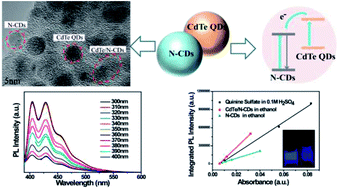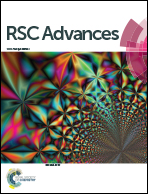Ultra-highly fluorescent N doped carbon dots-CdTe QDs nanohybrids with excitation-independent emission in the blue-violet region†
Abstract
Luminescent carbon dots (CDs) are of significant practical application interest such as in optoelectronic devices and sensitive probing in the life science and environment fields. In this study, N doped CDs-CdTe quantum dots (QDs) nanohybrids (CdTe/N-CDs) were synthesized by a plasma heating process using silk fibroin and CdTe QDs as precursors. The synthesis, doping, hybridizing and passivation of the CdTe/N-CDs were carried out in a single-step process. The as-synthesized CdTe/N-CDs dispersed in ethanol exhibited blue-violet photoluminescence with excitation-independent emission characteristics (strong emissions at 405 nm and 429 nm, and a weak emission at 456 nm). Additionally, the optimal excitation wavelength for the CdTe/N-CDs was found at 360–380 nm, which very closely matches the intrinsic wavelength of GaN-based LEDs. Furthermore, the obtained CdTe/N-CDs exhibited a very high quantum yield of ∼84%, showing great potential in developing chip-based high performance optoelectronics devices. The emission mechanism and emission enhancement by related factors including N-bonded configurations in the carbon base and the transfer of photo-excited electrons from the CdTe QDs to the N doped CDs were studied, as well.



 Please wait while we load your content...
Please wait while we load your content...